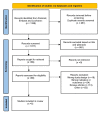Diagnostic Accuracy for Per-Patient Polyp Detection of Second-Generation Capsule Endoscopy Compared to Colonoscopy: A Meta-Analysis of Multicenter Studies
- PMID: 34646617
- PMCID: PMC8480223
- DOI: 10.7759/cureus.17560
Diagnostic Accuracy for Per-Patient Polyp Detection of Second-Generation Capsule Endoscopy Compared to Colonoscopy: A Meta-Analysis of Multicenter Studies
Abstract
Colon capsule endoscopy (CCE) or capsule colonoscopy can be used as colorectal cancer (CRC) screening option. We intended to analyze the concerning literature that compared second-generation CCE to standard colonoscopy for multicenter studies only. A literature search was performed in PubMed, Embase, and Web of Science. Study characteristics related to our research including sensitivity and specificity for per-patient polyps detection (size: ≥ 10 mm and ≥ 6 mm). Meta-analysis was performed using an open meta-analyst. Our research included five studies, involving a total of 1518 patients, with a total of 1305 analyzed patients. The adequate bowel preparation rate ranged from 70% to 90%. The rates of complete CCE transit fluctuated from 80% to 100%. Our meta-analysis illustrated that mean (95% confidence interval) per-patient sensitivity, specificity, and diagnostic odds ratio were: 0.86 (0.82-0.91) (p < 0.001), 0.88 (0.72-0.96) (p < 0.001), and 50.7 (18.5-138.9) (p < 0.001), respectively, for polyps ≥ 6 mm; and 0.86 (0.8-0.91) (p < 0.001), 0.96 (0.92-0.98) (p < 0.001), and 173.5 (98.4-305.8) (p < 0.001), respectively, for polyps ≥ 10 mm. We concluded that CCE had high sensitivity and specificity for per-patient polyps vs. standard colonoscopy. Nevertheless, the comparatively higher rate of unfinished CCEs limits the utilization of CCE for CRC screening.
Keywords: cce; colon cancer prevention; colon cancer survillence; colon capsule endoscopy; colonoscopy.
Copyright © 2021, Ali et al.
Conflict of interest statement
The authors have declared that no competing interests exist.
Figures



References
-
- Global cancer statistics 2020: GLOBOCAN estimates of incidence and mortality worldwide for 36 cancers in 185 countries. Sung H, Ferlay J, Siegel RL, Laversanne M, Soerjomataram I, Jemal A, Bray F. CA Cancer J Clin. 2021;71:209–249. - PubMed
-
- Screening for colorectal cancer: US preventive services task force recommendation statement. Davidson KW, Barry MJ, Mangione CM, et al. JAMA. 2021;325:1965–1977. - PubMed
-
- Wireless capsule endoscopy. Iddan G, Meron G, Glukhovsky A, Swain P. Nature. 2000;405:417. - PubMed
-
- Diagnostic accuracy of capsule endoscopy compared with colonoscopy for polyp detection: systematic review and meta-analyses. Kjølhede T, Ølholm AM, Kaalby L, Kidholm K, Qvist N, Baatrup G. Endoscopy. 2021;53:713–721. - PubMed
Publication types
LinkOut - more resources
Full Text Sources
